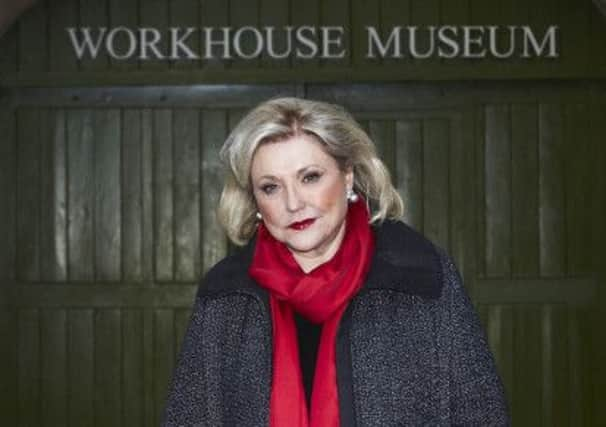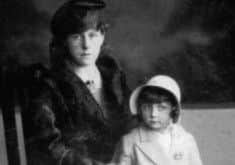Barbara Taylor Bradford: A woman of poverty who gave me will to succeed


Barbara Taylor Bradford is not a woman who flusters easily.
She did after all rise to through the ranks of Fleet Street when the newsrooms were dominated chain-smoking, hard drinking men. And having spent the last three decades or so as a bestselling author – her 1979 debut A Woman of Substance still ranks as one of the top 10 titles publisher Harper Collins has ever sold – she’s also turned public speaking into an effortless art as she travels round the world meeting and greeting the fans who have bought her books in their millions.
Advertisement
Hide AdAdvertisement
Hide AdYet earlier this year, stood on a rainy windswept street in Ripon, just a few yards from her grandmother’s former home, her usually serene composure slipped a little. She was there to meet her biographer Piers Dudgeon, whose book The Woman of Substance: The Life and Work of Barbara Taylor Bradford was first published in 2005.


It was Dudgeon who had first discovered Barbara’s mother, Freda, had spent time in the workhouse. What they didn’t know was why? However, the final piece of the jigsaw fell into place while filming a new television series, Secrets of the Workhouse.
Dudgeon had tracked down the birth certificates of Freda and her two younger siblings. All three were illegitimate. Shunned it seemed by her family, Barbara’s grandmother, Edith, had been left with no other option. In 1907 and again in 1910, she arrived on the doorstep of the Ripon workhouse, taking six-year-old Freda with her.
Without money or the support of relatives, it was the only route to free healthcare and it is estimated that 7,000 illegitimate children were born in workhouses like the one in Ripon.
Advertisement
Hide AdAdvertisement
Hide Ad“I really cried one day as I couldn’t imagine my mother, who was a very sweet and rather reserved woman, as a little girl put in the workhouse,” says Barbara, who visited the workhouse for the first time as part of the series. “She was very young to be there and I’m sure there was that feeling of embarrassment and shame.”
The workhouse is now a museum housing many artefacts from its time as a poorhouse, including the machine used to fumigate the clothes of the newest inmates and a small box of toys which would have been shared amongst the many children who for a while called those four walls home.
Barbara’s visit was the end of a long journey to delve into her past and it helped to shed light on her own mother’s upbringing.
“When I was 16 or 17 years old my mother did say many times, ‘I want you to have the kind of life I should have had’,” says the Leeds born author, who was raised in relative comfort in Armley where she attended Christ Church School, along with fellow writer Alan Bennett. “I always used to think ‘is she not happy with my father?’ They seemed to be, but now I think she was thinking of this place.
Advertisement
Hide AdAdvertisement
Hide Ad“I think being in the Ripon workhouse actually gave her that determination, that toughness and that will to make me have a different life, to give me the opportunities she didn’t have; basically to be a success.”
As well as the story of Barbara’s family, the series also features the stories of actors Brian Cox and Felicity Kendal, presenter Fern Britton and Kiera Chaplin, the granddaughter of Charlie. The latter’s London childhood was defined by poverty and before his ninth birthday he had already been sent to the workhouse twice.
With an absent father, when his mother was committed to a mental asylum, it should have been the end for the young Charlie. However, music halls provided an escape and at 19 he was signed to the prestigious Fred Karno company, which took him to America where he found both fame and fortune.
Chaplin, however, was very much the exception and the series doesn’t shy away from the grim reality of life in the workhouse.
Advertisement
Hide AdAdvertisement
Hide AdIn Victorian times, it represented the underbelly of society. In an era with no welfare benefits and no NHS, it was often the last rung on the ladder for those whose lives had slid into abject poverty. Once processed and forced to swap their own clothes for the plain workhouse uniforms, they would spend up to 10 hours a day engaged in monotonous tasks from breaking up rocks to picking apart rope.
The idea was simple – to shame the poor into standing on their own two feet and to show them that the life they would have inside the workhouse was worse than earning a pittance on the outside. However, while successive governments hoped they would act as a deterrent, they rarely did and while all who entered were free to leave any time they wished, it was hard not to feel imprisoned by poverty.
By the time they were shut down in 1948, of the 16m who had been unlucky enough to pass through their doors, five million never came out. While Barbara’s family did eventually escape, the programme also threw up further revelations of how her own family had been torn apart by the often brutal regime.
Her grandmother’s two youngest children – Barbara’s aunt and uncle – were sent by to Australia and Canada. Letters written after Edith’s death, show Freda had tried to bring her youngest sister back to the UK, but she wrote neither she nor the charity which sent her away in the first place could afford the £32 needed to process the application.
Advertisement
Hide AdAdvertisement
Hide Ad“The programme did give me some consolation although it upset me emotionally,” says Barbara, who this December will celebrate 50 years of marriage to her husband Bob Bradford, a film and television producer. “I’m glad I got the letters because it illuminated something for me and that was a certain sadness in my mother that I detected.”
It also helped answer some of the many questions which had arisen in the wake of Dudgeon’s book.
“Piers sent me the biography manuscript on my birthday,” she says. “By late afternoon, just as my husband came home, I had read the part about my mother being in the workhouse as a child and I couldn’t believe it. I was crying. Bob came into my office and said, ‘What on earth’s wrong? I just said, ‘My mother was illegitimate and she never told me’. He replied, ‘Put that away. It’s your birthday and I don’t care about this because we’re taking people to dinner, so come on, come out’. It was a combination of shock and surprise.”
At first Barbara was adamant that the news of her mother’s past be omitted from the book. However, after a few months of discussions, culminating with a meeting with Dudgeon in Paris, she agreed they could stay. It’s not a decision she regrets and while she would have dearly loved to have spoken to her mother about her childhood, she understands her reticence.
Advertisement
Hide AdAdvertisement
Hide Ad“My mother was born in 1904 and in those years, right through the Fifties and Sixties people were probably ashamed. I just wish that my mother had told me about her past because I might have been able to comfort her.”
Grim rhyme that summed up life for poor in an age before the welfare state
In the 19th-century there was a nursery rhyme which summed up many a man’s working life.
It went:
“Hush-a-bye baby, on a tree top.
When you grow old, your wages will stop,
When you have spent the little you made,
First to the poorhouse, then to the grave.”
Those words would have rung in the ears of those unfortunate enough to find themselves in the workhouse in Allhallowgate in Ripon where regulation coffins were ordered in bulk.
Advertisement
Hide AdAdvertisement
Hide AdNow a museum, documents contained in the archives show the wide range of backgrounds of many of those who found themselves destitute.
In 1861, as well as a number of down on their luck labourers, the workhouse was also home to a “former master wheelwright, gentleman’s servant, master shoe maker and farmer.” There were also 24 children under 12, the youngest two weeks old.
A workhouse was first opened on the site in 1776, but by the 1830s the cost of providing for the poor was a national concern. An inquiry was launched and it was recorded that Ripon had at the time 33 inmates, 11 men, nine women and 13 children who were occupied breaking rocks to mend roads.
In 1877 a separate building was opened to give vagrants in the area an evening meal and bed for the night.
Secrets from the Workhouse begins on ITV1 on June 25 at 9pm.